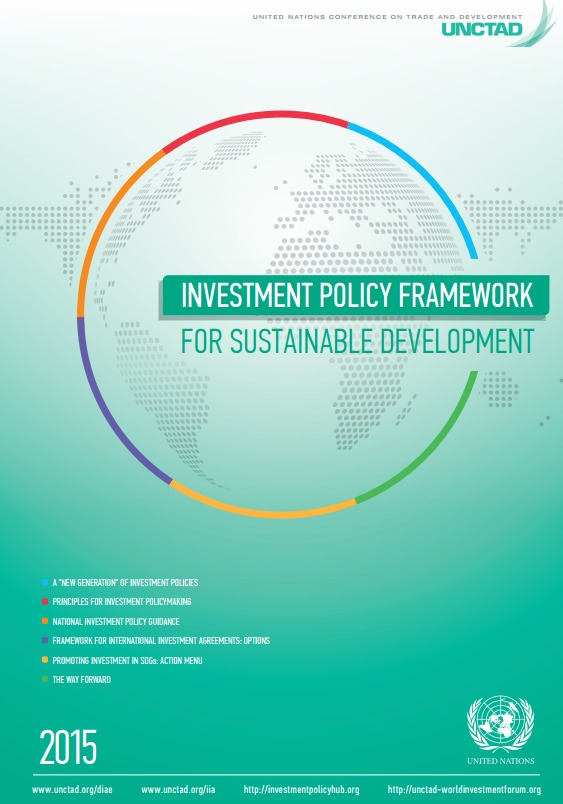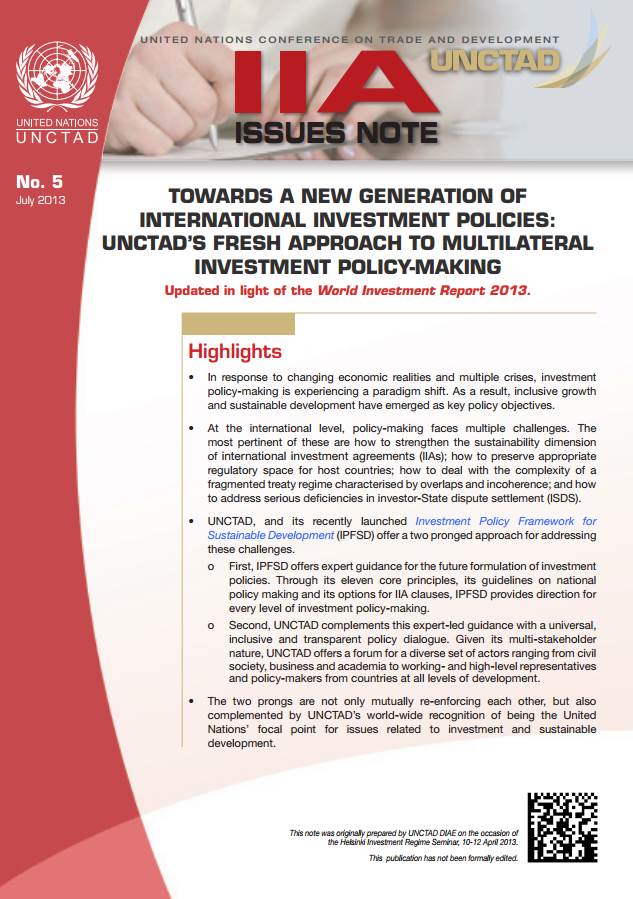
The number of mapped treaty elements exceeds The mapping of treaty provisions is not exhaustive, has no official or legal status, does not affect the rights and obligations of the contracting parties and is not intended to provide any authoritative or official legal interpretation. Sign In. If more than one option is selected under the same additional filter, the system displays treaties that correspond to at least one of the options selected i.
Translate page:
International investment rulemaking is taking place at the bilateral, regional, interregional and multilateral levels. It agreemens policymakers, negotiators, civil society and other stakeholders to be well informed about foreign direct investment, international investment agreements IIAs and their impact on sustainable development. For further information, please contact us via the online contact form. You can browse through IIAs concluded by a particular country or country grouping, view recently concluded IIAs, or use the Advanced Treaty Search for sophisticated searches tailored to your needs. The resulting database serves as a tool to international investment agreements unctad trends in IIA drafting, assess the prevalence of different policy approaches and identify treaty examples. International investment agreements IIAs are divided into two types: 1 bilateral investment treaties and 2 treaties with investment provisions. The category of treaties with investment provisions TIPs brings together various types of investment treaties that are not BITs.
Translate page:

For complaints, use another form. Study lib. Upload document Create flashcards. Documents Last activity. Flashcards Last activity.
Please wait….
For complaints, use another form. Study lib. Upload document Create flashcards. Documents Last activity. Flashcards Last activity. Add to Add to collection s Add to saved. UNCTAD seeks to further the understanding of the nature of transnational corporations and their contribution to development and to create an enabling environment for international investment and enterprise development.
In addition, the designations of country groups are intended solely for statistical or analytical convenience and do not necessarily express a judgement about the stage of development reached by a particular country or area in the development process.
The following symbols have been used in the tables: Two dots. Annual rates of growth or change, unless otherwise stated, refer to annual compound rates. Details and percentages in tables do not necessarily add to totals because of rounding. The material contained in this study may be freely quoted with appropriate acknowledgement.
The programme embraces capacitybuilding seminars, regional symposia, training ayreements, dialogues between negotiators and groups of civil society and the preparation of a series of issues papers. This paper is part of this series. It is addressed to government officials, corporate executives, representatives of non-governmental organizations, officials of international agencies and researchers.
The series seeks to provide balanced analyses of issues that may arise in discussions about international investment agreements. Each study may be read by itself, independently of the. Since, however, the issues treated closely interact with one another, the studies pay particular attention to such interactions. The series is produced by a team led Karl P. Mytelka; its principal advisors are Arghyrios A. Fatouros, Peter T. Muchlinski and Sanjaya Lall. The present paper is based on a manuscript prepared by Kenneth J.
The final version reflects comments received from Mark Koulen and Manfred Schekulin. It was desktop published by Teresita Sabico. Countries such as Investmejt, Morocco and Peru have also contributed to the work programme by hosting regional symposia.
All of these contributions are gratefully acknowledged. Scope of international investment agreements Definitions of key terms Historical context Impact on investment definitions Which investors are covered The broad asset-based definitions of investment Narrowing the asset-based definition Limitation to permitted investment under host country laws Limitations on time of establishment Limitations on the nature of the investment.
Limitations on the size of investments Limitations agreemnts the sector of the economy Other approaches: enterprise-based and transaction-based definitions Entities considered investors Exclusions based on legal form Exclusions based on purpose Exclusions based on ownership Establishing the link Natural persons Legal entities Own or control Other terms Transnational corporation or multinational enterprise Example of a broad definition of investment GATS definition of control Definitions of transnational corporations and enterprises Interaction across concepts and issues Such agreements typically apply to investment in the territory of one country by investors of another country.
By themselves and in conjunction with the operative provisions, these definitions may play one or both of two critical functions in an agreement: they identify those assets to which the treaty applies; and they may determine the nature of the obligations created by the treaty. The discussion will consider both how these terms have been defined in existing investment agreements and how these definitional provisions interact with key operative provisions of investment agreements.
The broadest definitions embrace every kind of asset. They include in particular movable and immovable property, interests in companies including both portfolio and direct investmentcontractual rights such as service agreementsintellectual property, and business concessions.
Each of these types of investment has different economic and development implications for home and host countries.
The parties to intrnational investment agreement thus may not wish to liberalize, promote, protect or regulate all investment flows in the same manner or to the same extent.
For example, the economic development policies of treaty parties may call for excluding certain assets from coverage by a particular investment agreement or for treating certain assets invsstment under the agreement. All of these limitations have appeared in at least some investment agreements, generally in furtherance of the economic development policies of some or all of the parties.
Alternatively, a host country seeking to exclude or regulate certain types of foreign investment may decide to impose conditions on the establishment of particular foreign investments or agredments exclude them from its territory entirely.
Furthermore, a host country may prefer language limiting the applicability of specific provisions to certain types of investment. Investment agreements must specify not only their geographical and temporal coverage, but, most importantly, their subject-matter coverage.
In particular, this paper identifies a range of alternatives from wide to narrow definitions and shows how these might affect, on the one hand, the extent of treaty coverage granted to foreign investors and, on the other, the degree of uunctad State discretion in directing and implementing its foreign investment policy. Of particular importance in this regard is an understanding of approaches to definitions. The answers to such questions materially affect the actual role of the agreements.
Indeed they guide the structure of the present paper which, in section I, elaborates on these initial conceptual issues. Section II then provides a stocktaking and analytical background: it describes how these terms have been defined in existing international instruments and explains the rationales for various definitions. Section III analyses the interaction of these definitions with some of the other issues addressed by investment agreements.
It is here that the interaction between the scope of Scope and Definition the definitions used — and the means by which other concepts further affect the operation of definitional terms — is considered. Thereby the full range of concerns relevant to determining the subject-matter of an investment agreement is shown.
Finally, the concluding section assesses the development implications behind the wider and narrower definition clauses identified in section II. The geographical scope of an investment agreement is determined, to begin with, by the number and identity of the States that are party to it. It is also determined invsetment the territorial limits of the States concerned. To ascertain the exact temporal inrernational of an agreement, its date of invfstment into force with respect to each party and its duration has internatilnal be determined.
This issue generally is not addressed in provisions on definitions and will not be discussed. These terms refer to major dimensions of the economic activities to which the provisions of an agreement apply.
Accordingly, they play Scope and Definition an important agreemfnts in determining the normative content of an instrument. Typically, an international investment agreement applies only to certain types of investment. This paper discusses these terms at length. In short, while there are at least three dimensions to the scope of an investment agreement, it is chiefly with respect to the subject matter of an instrument that definitions are important.
Whether the instrument includes explicit definitions or not, however, its application requires that the parties use some working definition of these terms. Some appreciation of the meaning of the terms is thus essential to an understanding of the scope of any investment instrument. Definitions of key terms Definitions serve many purposes. In international agreements, they raise difficult policy issues and are often the subject of hard bargaining between uncgad negotiating parties.
Thus, the decision on a definition of terms will be made on a case-by-case basis, taking into account the purpose and circumstances of the negotiations at stake. Investment a. Historical context There is no single, static conception of what constitutes foreign investment. Rather, the conception has changed over time as the nature of international economic relations has changed. Prior to the middle of the nineteenth century, trans-frontier capital flows typically assumed the form of lending by European investors to borrowers in other International investment agreements unctad States Kindleberger,pp.
The difficulties involved in travel and communication over long distances were a strong impediment to foreign direct investment FDI. In that period, foreign-owned property in a country often took the form of merchandise imported for sale to the domestic market or vessels that had shipped the merchandise. Foreign nationals — more often than not, resident in the home countries — might also hold bonds that had served to finance foreign manufacturing and transportation enterprises.
In addition, foreign nationals residing abroad generally owned for their personal use and consumption a certain amount of personal and real property in the host country where they resided. International investment law was thus concerned principally with the protection of tangible property against seizure unctas the right of creditors to collect debts.
International Economic Institution – GATT, UNCTAD & IMF
Investment Policy Hub
AzerbaijanTurkmenistan. Sauvant, Khalil Hamdani and Pedro Roffe …. Full text: en ko. CanadaMexicoUnited States of America. Identifying core elements in investment agreements in the APEC region. IIA Navigator International investment agreements IIAs are divided into two types: 1 bilateral investment treaties and 2 treaties with investment provisions. ArgentinaJapan. A treaty is included in a country’s IIA count international investment agreements unctad it is formally concluded; treaties whose negotiations have been concluded, but which have not been signed, are not counted. Brazil — Guyana BIT Thematic Taxonomy.

Comments
Post a Comment